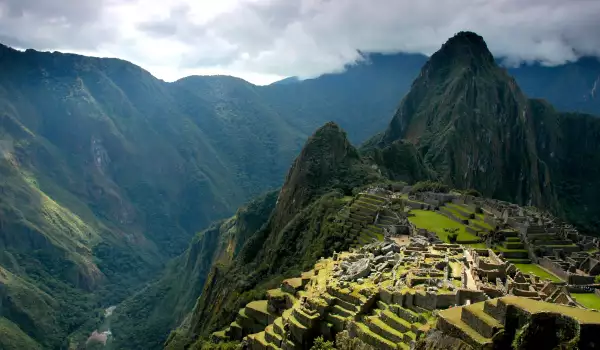Machu Picchu

Machu Picchu is one of the wonders of the world and one of the most popular worldwide cultural and historical attractions. Machu Picchu is relatively a small architectural complex that remnants of past grandeur of a major civilization and is located in the lands of the present day country of Peru.
Built by the Incas in the 15th century, Machu Picchu is now included in the list of World Cultural and Natural Heritage of UNESCO. Aka, Lost City of the Incas, Machu Picchu is located at 2430 m altitude in the Andes, 112 km from Cusco, at the foot of the Sacred Valley of the Incas.
In fact, Machu Picchu is not with grandiose proportions, it was a small town. It has no more than 200 structures, representing the most common types of temples, residences, warehouses and other facilities. Most of these buildings are built from precision machined stones and firmly attached one to another plate.

The sanctuary complex of Machu Picchu is located at an average altitude of 2350 meters, with an area of 325 square meters.According to specialists in Machu Picchu lived no more than 1200 people. The Incas at Machu Picchu worshiped the sun god - Inti.
The ancient Inca fortress of Machu Picchu was discovered accidentally in 1911 and since then is one of the most interesting archaeological sites and tourist attractions. The credit for the discovery of Machu Picchu goes to the American archaeologist Hiram Bingam who accidentally stumbled on the complex during the expedition.
The most difficult to understand of the exclusive area in the Andes mountains has led experts, researchers and historians to have conflicting views on the use of the city. According to research Machu Picchu was the safest refuge of the Incas. Scientists believe that Machu Picchu is where inca Mancala was defeated and his people fled the capital after a siege of Cuzco in 1536. This was after a failed uprising against the Spanish Inca conquerors.

The strategic location of Machu Picchu has provoked another very popular hypothesis. According to which, Machu Picchu was a "fortress", which served as a watch-guard and was used by the Incas as a symbol of their dominant position in the Amazon region, near the village of Cuzco. In support of this contention come the scenes that depict clashes between soldiers and ordinary soldiers that the Incas called "chunchos" (inhabitants of the jungle). These battle scenes are found on lacquered wooden bowls made by the Incas of Machu Picchu.
The third hypothesis states that Machu Picchu was an important religious center. In support of this claim comes the inaccessibility of the largest highland resort of Machu Picchu and the presence of altars. It is believed that Machu Picchu is so high in altitude because then the Incas could be the closest to the gods and even more so could touch them.
Ever Machu Picchu was part of a huge complex of fortresses, which the Incas used to protect against incursions of the Indians coming from the jungle. Main Machu Picchu is divided into four parts. Northwest is located in the area, which was probably used for religious purposes. Namely there are the so called, Sacred Square and Temple of the three window, Sacred Temple and mansion of the priests. There is also the build of the solar laboratory, through which the Incas were able to determine the seasons and time in the shadows that the sun leaves on the rocks.

In the north of Machu Picchu probably were located the large buildings of the complex. The southwestern area was a place for the observation tower and several buildings. Near numerous terraces for agricultural purposes are built the smallest and most modest buildings standing on the small and narrow streets. At the bottom of the terraces of Machu Picchu is a tomb.
It was during the excavations that 135 skeletons were found and a curious fact is that 109 of them were identified as female. That is the reason for researchers to believe that Machu Picchu was inhabited mostly by women who elect Inca and were hidden in the city which was then unknown to the Spanish conquerors.
To this day it remains a mystery and another mystery is how the Inca built their secret city of Machu Picchu. There are no definite explanations of how they transported to the top of the mountain the huge blocks of limestone which were needed for the advancement of the city.










